
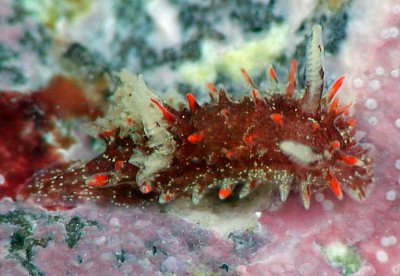
Okenia echinata
Baba, 1949
Order: NUDIBRANCHIA
Suborder: DORIDINA
Superfamily: ANADORIDOIDEA
Family: Goniodorididae
DISTRIBUTION
Known from Japan and eastern Australia
PHOTO
Osezaki, Suruga Bay, Japan,
Upper: 30 Apr 2002. Approx: 5mm long, Depth: 5m.
Lower: 27 Jul 2002. Approx: 5mm long, Depth: 2m. Photos: Jun Imamoto
Known previously only from Japan, the original description of Okenia echinata was of a uniformly brown animal with scattered white spots and triangular papillae. Baba likened it to a small holothurian. That colour pattern is rather different from that of animals from eastern Australia, [see message #12455 ] but recent records from Japan (see Jun Imamoto's message #8858; Tomohiko Kurihara's message #9146) show this species is very variable in colour with animals ranging in colour from pale brown, as originally described by Baba, to those with a bright red background colour, and others with a dark brown background colour and bright red papillae.
The body is low and elongate with the mantle edge forming a distinct overlap around the body. There are many short, bluntly pointed tubercles attached around the mantle edge, one specimen having 14 on each side. In some specimens, the most anterior pair of tubercles appear compound, and are in fact a cluster of 2 or 3 individual tubercles. Similarly, the most posterior pair of tubercles can also be compound in some cases. Scattered all over the dorsum are slightly smaller, but similarly shaped tubercles. They do not seem to form a regular pattern. The head is separate from the foot and could best be described as a large bilobed oral veil. There are at least 8 bipinnate gills arrange in a large arch around the anal papilla. It grows to at least 10mm long alive.
The general shape, large bilobed head and many conical dorsal papillae all characterise this species externally. Okenia opuntia Baba 1960 and Okenia babai Hamatani 1961, both reported from Japan, are similar in general body shape but not enough is known of their colour and anatomy to make a proper comparison.
-
Baba, K. (1949) Opisthobranchia of Sagami Bay collected by His Majesty The Emperor of Japan. Iwanami Shoten, Tokyo. 194pp., 50 Pls.
-
Baba, K. (1960) The genera Okenia, Goniodoridiella and Goniodoris from Japan (Nudibranchia - Goniodorididae). Publications of the Seto Marine Biological Laboratory, 8(1), 79-83, pls 7-8.
-
Hamatani, I. (1961) Preliminary account of a new species of Okenia from Osaka Bay, Japan (Nudibranchia - Goniodorididae). Publications of the Seto Marine Biological Laboratory, 9: 363-365.
-
Rudman, W.B. (2004) Further species of the opisthobranch genus Okenia (Nudibranchia: Goniodorididae) from the Indo-West Pacific. Zootaxa, 695: 1-70.
Rudman, W.B., 2004 (December 21) Okenia echinata Baba, 1949. [In] Sea Slug Forum. Australian Museum, Sydney. Available from http://www.seaslugforum.net/find/okenechi
Related messages
Re: Okenia echinata from Ratnagiri, India
December 21, 2009
From: Vishal Bhave
Concerning message #22990:
I forgot to mention that those were close to each other and might be mating ! as I collected them after waiting for 5 minutes.
Vishal Bhave
vishalbhave@gmaill.com
Bhave, V.J., 2009 (Dec 21) Re: Okenia echinata from Ratnagiri, India. [Message in] Sea Slug Forum. Australian Museum, Sydney. Available from http://www.seaslugforum.net/find/22993Thanks Vishal,
Best wishes,
Bill Rudman
Re: Okenia echinata from Ratnagiri, India
December 16, 2009
From: Vishal Bhave

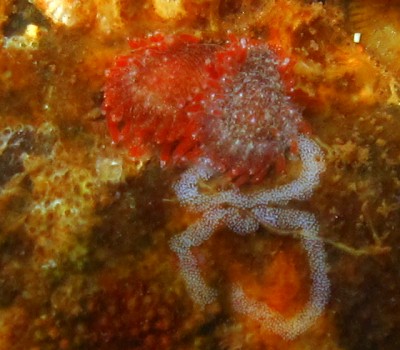
Concerning message #22982:
Today I got these Okenia echinata on red encrusting bryozoan.
Locality: Rocky patch, Mandavi, Ratnagiri, 130 cm, Maharashtra, India, Arabian sea, 15 December 2009, Intertidal rockpools with lose pebbles encrusted with variety of Hydroids, bryozoans and ascideans. Length: 6- 8 mm. Photographer: Vishal Bhave.
Vishal Bhave
vishalbhave@gmail.com
Bhave, V.J., 2009 (Dec 16) Re: Okenia echinata from Ratnagiri, India. [Message in] Sea Slug Forum. Australian Museum, Sydney. Available from http://www.seaslugforum.net/find/22990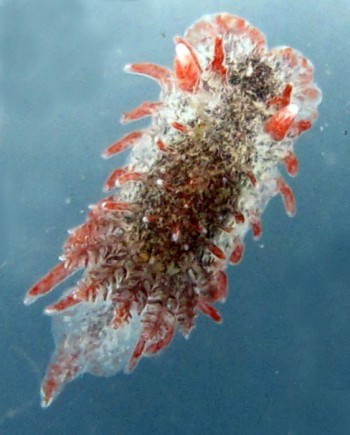
Dear Vishal,
That was quick! It sees to be very similar in colour to the earlier animal.
Best wishes,
Bill Rudman
Okenia echinata from Ratnagiri, India
December 15, 2009
From: Vishal Bhave
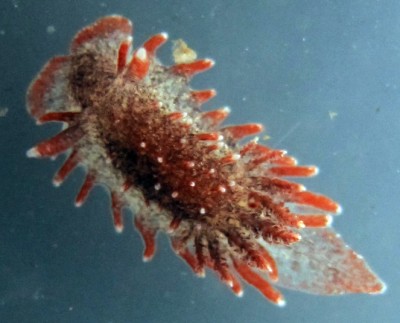
Concerning message #8858:
Dear Bill,
In survey along coastal Ratnagiri, I observed a goniodorid on rocks encrusted with bryozoans [see photo]. It might be Okenia echinata ? I am also attaching an image with eggcases.
Locality: Ambolgad, Rajapur, Ratnagiri, 1- 4 feet, Maharshtra, India, Arabian sea, 13 December 2009, Intertidal with rocks encrusted with bryozoans. Length: 6-8 mm. Photographer: Vishal Bhave.
need more images?
Vishal Bhave
vishalbhave@gmail.com
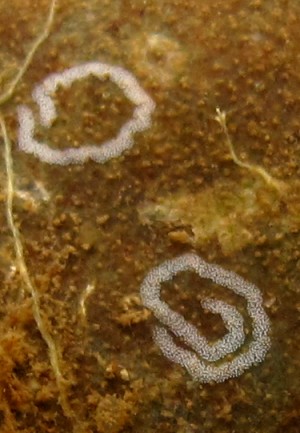
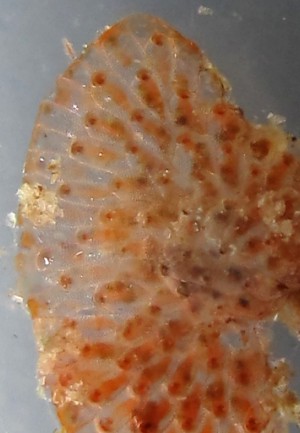
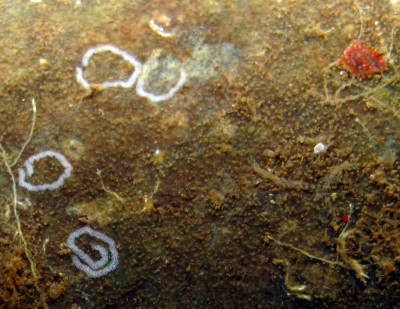
Dear Vishal,
I am pretty sure this is indeed O. echinata which would extend its distribution much further west than at presently known. Was this the only specimen you saw? It would be interesting to know how much colour variation occurs in your part of the world.
Best wishes,
Bill Rudman
Another Lophodoris? from Japan
September 8, 2009
From: Yuriko Taniguchi
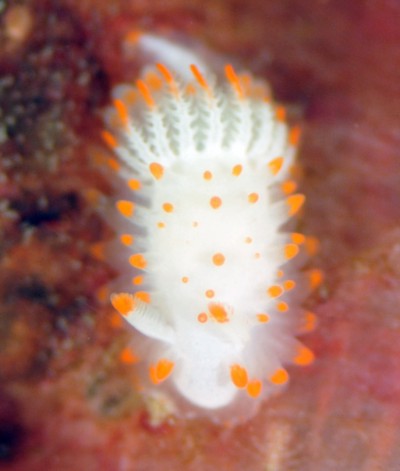

Dear Bill
The other day, I found a sea slug which I had not seen before. Then, I looked for it in the Sea Slug Forum species list. Although I thought that it was similar to "Lophodoris sp. 1 ", the color of gills and rhinophores differs a bit.
Is the one I saw a colour variation or a different species?
Locality details: JAPAN, Pacific Ocean (Latitude 34°17, Longitude136°39?, Depth: 15-16 m. Specimen length: about 10 mm. 30 August 2009, on a reef. Photographers: Mr.K.Ito & Mr.J.Go
Best Regards,
Yuriko
fwpc8434@nifty.com
Taniguchi, Y, 2009 (Sep 8) Another Lophodoris? from Japan. [Message in] Sea Slug Forum. Australian Museum, Sydney. Available from http://www.seaslugforum.net/find/22648
Dear Yuriko,
This is an interesting find. Could you give me a few more details about where you found it please?
It certainly has similarities in shape to the animal I have called Lophodoris sp. 1 but it has some colour differences. I thought perhaps it was a colour form of Limacia cockerelli which is found on the northeast coast of North America, but your photo of the head shows the large oral hood arrangement found in Lophodoris and Okenia. If you have a photo showing the posterior end of the body it would be interesting.
I suspect this is the same as the animal in Dong Bum Koh's message from Korea [message #17046] which we have tentatively identified as a colour form of Okenia echinata.
Best wishes,
Bill Rudman
Okenia echinata ? from Sth Korea
July 6, 2006
From: Dong Bum Koh
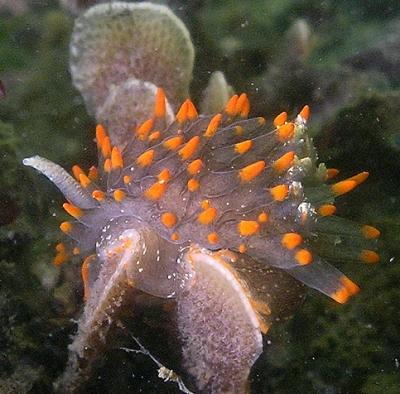
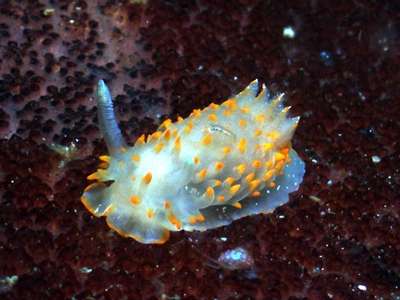
Dear Bill,
All of these photos look like the same species which I identified as Okenia echinata in Sea Slugs of Korea p66. But the animal in the book had a distinct yellowish background colour'
I'm not sure, could you help me with these ID?
Upper: 9 May 2006 -10 m. Yeo Soo city. Jeon Nam Prov., South Sea, Korea. Photo: Ok Soo Kim. Middle, Lower photos: 26-27 June - 13-15 m, Yeong Duk, Kyung Book Prov. East Sea, Korea. Photo: Gwang Bouk Kim. Length: Approx. 10 mm. in all cases.
Best regards,
Dong Bum Koh
drkoh@seasee.co.kr
Koh, D.B., 2006 (Jul 6) Okenia echinata ? from Sth Korea. [Message in] Sea Slug Forum. Australian Museum, Sydney. Available from http://www.seaslugforum.net/find/17046
Dear Koh,
Althpough I think this species is the same as the one in your book, I suspect it is not Okenia echinata. The papillae seem to be far more numerous both along the sides of the mantle, and on the dorsum. The only way to be sure would be to look at the anatomy of some specimens.
Most species of Okenia feed on bryozoans, so I guess the animal in the upper photo is on its food. I am not sure if the dark reddish brown object the lower animals are on is a bryozoan as well. Perhaps yu could ask Gwang Bouk Kim if he has a photo showing the background in more detail. Okenia opuntia (Baba, 1960) is the only other possible identification, but I don't have Baba's paper at hand so will have to wait until I have a chance to check it out.
Best wishes,
Bill Rudman
Okenia echinata? from Northern N.S.W.
December 23, 2004
From: Denis Riek
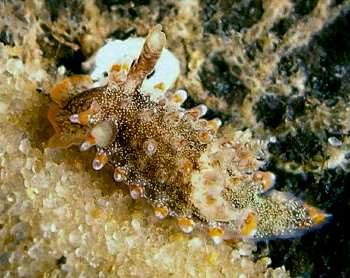
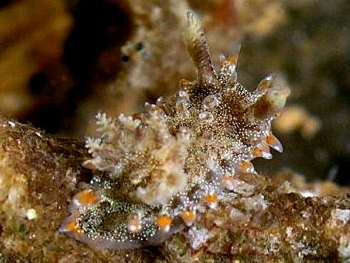
Hello Bill,
Congratulations on getting the Forum running again. This is great news!
Many new species turned up in the Brunswick River over winter & spring before the big flush a fortnight ago. Sakuraeolis nungunoides & Cuthona yamasui were a surprise, also about a dozen I am having trouble putting a name to.
This one appears to be very similar to Okenia echinata. Only 8 mm long, it was found in 3 metres on the main sea wall on what I think is a bryozoan I am still trying to ID.I was unable to photograph in situ due to strong current and poor visibilty
Locality: Brunswick River, Depth: 3 metres., New South Wales, Australia.
Length: 8 mm.
26 June 2004
On ?bryozoan on sea wall
Photographer: Denis Riek
Regards,
Denis.
denisriek@hotmail.com
Riek, D.W., 2004 (Dec 23) Okenia echinata? from Northern N.S.W.. [Message in] Sea Slug Forum. Australian Museum, Sydney. Available from http://www.seaslugforum.net/find/12814Dear Denis,
Yes I would consider this to be a colour variety of Okenia echinata. It is very similar to the one illustrated in my recent message [#12455] from New South Wales. It would certainly be interesting to get a sample of the possible bryozoan food. If you have a specimen I could arrange to have it identified. It is good to see how the Forum can generate all this new information about Okenia just in a couple of days. I look forward to hearing about some of your other finds.
Living in a land so short of water, I guess it is churlish to complain about these flushes of flood water which can so quickly destroy wonderful nudibranch populations. In Sydney Harbour it is sometimes heartbreaking to see the overnight destruction of rich nudibranch habitat as salinity drops with the sudden influx of rainwater overflow - but I guess we have to balance that against having some worthwhile rain to support the rest of our lives!
Best wishes,
Bill Rudman
Okenia echinata from eastern Australia
December 21, 2004
From: Bill Rudman
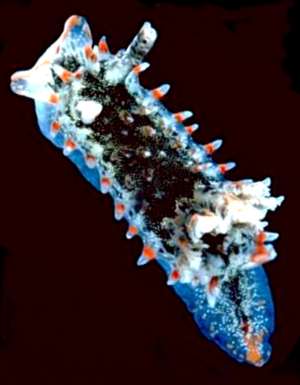
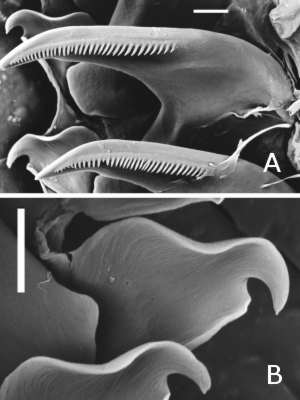
PHOTO: Upper. Arrawarra rock platform, Woolgoolga, New South Wales, Australia, 3 December 1990, [Photo only] AM C164553. Photo: Bill Rudman. Lower. SEM photos of the radula. A, left section of radula showing 2 large inner and 2 small outer teeth. B, close-up of two outer teeth on right side. Callala Point, Jervis Bay, New South Wales, Australia: 6 October 1975, 8 mm long preserved, AM C103287. Scale bar = 10 µm. Photo: G. Avern.
To accompany the new information being posted today on species of Okenia here is a photo of Okenia echinata, and its radula, from eastern Australia. Australian animals are translucent white with a many opaque white spots scattered over the dorsum. The dorsal surface has dark brown to black pigmentation, which in some animals gives the dorsum a uniform dark brown to black colouration and in other specimens appears as scattered dark brown to black patches, or even as regions of dark spotting. Scattered over this dark pigmentation are small opaque white spots. There is a broken orange line along the anterior edge of the head and oral lobes, and each of the translucent white mantle papillae has an orange band around its mid-region, although in some tubercles the orange band can reach to the tip. The gills are translucent white with some orange markings on the outside of the rachis. The rhinophores are translucent white with brown speckling, and often there is some orange speckling near the tip. The foot has a dark brown black band down the posterior midline which is replaced at the posterior tip by a patch of orange. There are also small white spots scattered all over the foot.
The original description of Okenia echinata from Japan, is rather different in colour, the animal being a uniformly brown animal with scattered white spots and triangular papillae. This colour pattern is rather different from that of animals from eastern Australia, but recent records on the Forum from Japan (message #8858; message #9146) show this species is very variable in colour.
The shape of the radulat teeth is typical of the goniodorids with a large inner tooth and a small outer tooth on each side of the midline in each row. The radular formula of the animal photographed was 18 x 1.1.0.1.1. The innermost tooth has a broad base and a long elongate pointed cusp with many narrow, relatively long, pointed denticles along the cutting edge. The much smaller outer teeth have a broad quadrangular base with a large recurved pointed cusp
- Rudman, W.B. (2004) Further species of the opisthobranch genus Okenia (Nudibranchia: Goniodorididae) from the Indo-West Pacific. Zootaxa, 695: 1-70.
Re: Okenia echinata from Japan
February 11, 2003
From: Tomohiko Kurihara
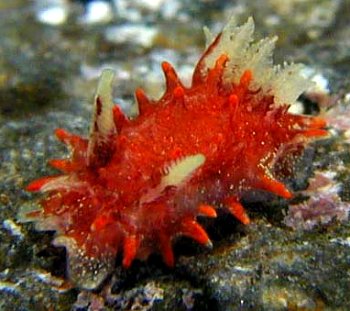
Dear Bill,
Jun Imamoto asked me if I had a photo with an intermediate colour pattern of Okenia echinata.
Here is a photo of an intermediate colour pattern of a red coloured animal with white specks.
Date: Osezaki Suruga bay, Japan.
Date: June, 2002 - night diving
Size: 10mm
Depth: 2m
Best Regards,
Tomohiko Kurihara
tomo-coo@ny.tokai.or.jp
Kurihara, T., 2003 (Feb 11) Re: Okenia echinata from Japan. [Message in] Sea Slug Forum. Australian Museum, Sydney. Available from http://www.seaslugforum.net/find/9146Dear Tomohiko,
Thanks very much,
Bill Rudman
Re: Okenia echinata from Japan
January 20, 2003
From: Jun Imamoto
Dear Bill,
Concerning your question I am sorry to say, I have only photographed these 2 individuals. But, Okenia echinata seems to be a sea slug we see once in a while at Osezaki, Suruga Bay. So hopefully I can let you know soon if we find any with an intermediate colour pattern.
Best Regards,
Jun Imamoto
imamoto@wips.co.jp
Thanks Jun,
Bill Rudman
Okenia echinata from Japan.
January 18, 2003
From: Jun Imamoto


Dear Bill,
Here are some photos of Okenia echinata for the Forum. These sea slugs were found on weed covered rocks. I am happy if these reports are useful for your research.
Data: Osezaki Suruga Bay, Japan
Upper right: 27 Jul 2002, Size approx: 5mm, Depth: 2m, Temperature: 26C
Lower photos: 30 Apr 2002, Size approx: 5mm, Depth: 5m, Temperature: 19C
Photos: Jun Imamoto
Best Regards,
Jun Imamoto
http://umiushi.zive.net/
imamoto@wips.co.jp
Imamoto, J., 2003 (Jan 18) Okenia echinata from Japan.. [Message in] Sea Slug Forum. Australian Museum, Sydney. Available from http://www.seaslugforum.net/find/8858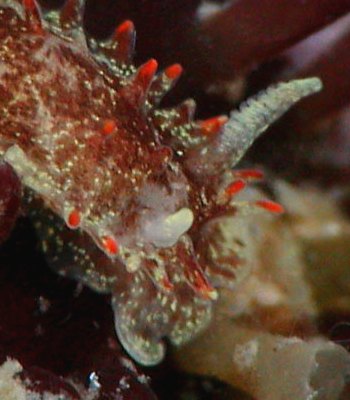
Thanks Jun,
I don't think there has been anything published on this species since Baba's original description. Your lower photo, of the plain brownish animal with white specks, matches Baba's original description very well. I didn't realise this red marked animal was a colour form. Have you any photos that show individuals with an intermediate colour pattern? For example light brown animals with red on the papillae, or dark brown-black animals with no red colouration.
Best wishes,
Bill Rudman
